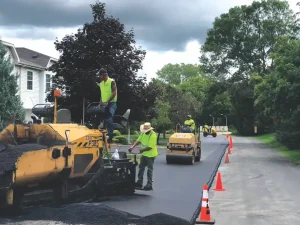Asphalt is incredibly strong, durable, and versatile with the ability to withstand thousands of pounds of weight, making it an ideal paving material for parking lots and roadways. However, it has its weaknesses – the material is sensitive to extreme weather conditions. Asphalt may crack due to the changing seasons and sometimes unpredictable weather. In this article, we uncover how asphalt responds to different weather conditions and what you can do to prevent the adverse effects of seasonal changes.
Effect of Seasonal Changes
Winter
Winter is often characterized by ice, snowfalls, cold rain, sleet, hail, and extreme cold all of which contribute to asphalt damage. In fact, winter months with freezing temperatures are the biggest nightmares for asphalt pavements. Winter causes asphalt to crack in two ways:
Firstly, temperatures below the freezing point cause asphalt to contract and shrink, creating tension within the pavement. The more extreme the temperature, the stronger the tension, resulting in cracks developing in the pavement. Also, if the temperature decreases too rapidly, asphalt will contract quicker and build tension faster, causing an increased chance of cracking.
Secondly, temperatures below the freezing point will cause water trapped beneath asphalt pavement to freeze. Water tends to expand when frozen, causing the ground to heave. However, this is uncommon and usually affects poorly maintained asphalt or ones with poor drainage.
Spring
Weather usually becomes warmer in the spring and winter ice and snow begin to melt. The soils beneath the pavement saturate as the ice below (frost heaves) melt. Additionally, this season is characterized by rain, meaning rainwater can infiltrate cracks, seep beneath the pavement, and puddle in deformed areas caused by frost heave. Water is the biggest threat to asphalt in Spring – whether water puddles on top, flows across, moves into the cracks, or seeps beneath asphalt pavement, it causes it to deteriorate.
Summer
The season is characterized by less rain, more sunshine, and sometimes extreme heat. Summer may not do much to distress asphalt pavement. However, extreme heat can affect asphalt in three ways – asphalt pulling away from the surface, weakening it, and making it vulnerable to potholes, softening of asphalt material and making it susceptible to damage from traffic, and UV rays penetrating the asphalt and causing it to fade and deteriorate.
Fall
Just like the rest of the seasons, fall comes with its set of challenges for asphalt pavement. It is characterized by increased rainfall, meaning water is the biggest threat to asphalt pavement. Water picks up from the effects left by the scorching days in summer to cause further damage to asphalt. However, the impact in fall is not as adverse as in the seasons before.
What You Can Do and How Pro-Pave Can Help
Mother nature can be unforgiving and her wrath is usually hard to predict. Nonetheless, being educated and prepared for any scenario is crucial. Always be proactive in your asphalt repair and maintenance and plan ahead to avoid or minimize the implications of unexpected weather changes. Perform regular inspections, repairs, and maintenance with the goal that your asphalt pavement doesn’t deteriorate sooner than it should.
Most importantly, it’s important to work with a professional and experienced contractor for your asphalt installation, repairs, and maintenance. At Pro-Pave Inc, we’re a reputable commercial concrete and asphalt paving company with several years of serving clients of all kinds.
Check out our service page for more or call us at (703) 433-9500 for a free consultation.





